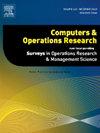Optimizing the Transport of Organs for Transplantation
IF 4.1
2区 工程技术
Q2 COMPUTER SCIENCE, INTERDISCIPLINARY APPLICATIONS
引用次数: 0
Abstract
As an organ becomes available for transplantation, a recipient must be selected. Usually, donor and recipient are geographically apart. Therefore, the transport of the organ must be planned and executed within the time window imposed by the maximum preservation time of the organ, which can impact recipient selection. The Cold Ischemia Time - CIT, that is the time elapsed between the surgical removal of the organ and its transplantation, must be the minimum possible to improve the transplantation success. In this sense, the air transport becomes the best option and, sometimes, it is the only way to deliver the organ before perishing. The planning of an organ transportation means choosing, among thousands of possible sequences of flights, the option that delivers the organ faster to its destination. This problem can be modeled as a resource constrained shortest path. Given the urgency and importance of this task, which is solved manually in Brazil, we present a labeling algorithm to find the optimal sequence of flights. Computational tests performed on 25 Brazilian real cases showed a reduction, on average, of 37,46% for the CITs and 44,17% for the transport times.
求助全文
约1分钟内获得全文
求助全文
来源期刊

Computers & Operations Research
工程技术-工程:工业
CiteScore
8.60
自引率
8.70%
发文量
292
审稿时长
8.5 months
期刊介绍:
Operations research and computers meet in a large number of scientific fields, many of which are of vital current concern to our troubled society. These include, among others, ecology, transportation, safety, reliability, urban planning, economics, inventory control, investment strategy and logistics (including reverse logistics). Computers & Operations Research provides an international forum for the application of computers and operations research techniques to problems in these and related fields.
 求助内容:
求助内容: 应助结果提醒方式:
应助结果提醒方式:


